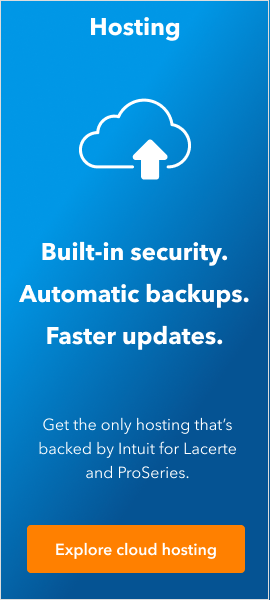- Topics
- Training
- Community
- Product Help
- Industry Discussions
- User Groups
- Discover
- Resources
- Intuit Accountants Community
- :
- ProSeries Tax
- :
- ProSeries Tax Discussions
- :
- Automatic Background Updates
Automatic Background Updates
- Mark Topic as New
- Mark Topic as Read
- Float this Topic for Current User
- Bookmark
- Subscribe
- Printer Friendly Page
- Mark as New
- Bookmark
- Subscribe
- Permalink
- Report Inappropriate Content
♪♫•*¨*•.¸¸♥Lisa♥¸¸.•*¨*•♫♪
![]() This discussion has been locked.
No new contributions can be made. You may start a new discussion
here
This discussion has been locked.
No new contributions can be made. You may start a new discussion
here
- Mark as New
- Bookmark
- Subscribe
- Permalink
- Report Inappropriate Content
Maybe because we all launched a revolt last year about automatic updates being so automatic, someone at Intuit actually listened to us. There is no way I want Intuit crashing my airplane into the side of a mountain because the autopilot took over. I'm quite happy with the 2022 software leaving me in the cockpit for tax season.
Slava Ukraini!
- Mark as New
- Bookmark
- Subscribe
- Permalink
- Report Inappropriate Content
I think my Win 11 system does it automatically by default, but my office system is still Win 10 and hadnt been updated in I dont know how long LOL I never even bugged me to update!
I was more pissed that it insisted I had to be an Admin to choose the option!
♪♫•*¨*•.¸¸♥Lisa♥¸¸.•*¨*•♫♪
- Mark as New
- Bookmark
- Subscribe
- Permalink
- Report Inappropriate Content
Perhaps a few notes would be helpful, especially as this is the time for installing new programs and even setting up new Windows 11 computers. Maybe this will even serve as an easy reference.
Windows computers treat us as a User. We can set up more than one user account to control access rights (such as limiting kids to not accessing financial folders and apps or a Guest profile), but there always is at least one user name/user account, now, but that is not considered Admin unless it is made Admin. That doesn't require you to be logged into a Microsoft account. It's called a Local User. You typically see it on the lock screen, even if you don't use a lock password.
You can set up your new computer fresh (or change an older one) so that a nonadmin local user account is Admin. I see this article has both W10 and W11, new, add and change, instructions:
When installing a program from a download, instead of double-click to "run" or download and run, I like to right click the installation file (so, you would go to the download folder to see it) and use the "Run as Admin" right there. That is supposed to install it elevated for this Windows username. For instance, I always recommend installing QuickBooks as "Run as Admin" and "for all users" because of the background update issues.
When you have an installed program shortcut (icon) that you use to launch a program, and you see a little boxed arrow, this indicates it is a shortcut to the real file that is the real launch program. Right click it and use Properties > Shortcut tab, to see the button for Open File Location (or it might already be on that right-click menu). That takes you to another folder and the real file (the executable) in the Windows Explorer view, where you can then right click that file and use Properties > Compatibility tab. Checkmark here to Run as Admin (and you might see a button to take you where you can "change settings for all users") and this sets it as Admin as the default.
All of these functions are available to help you control the way things work, who can use which desktop system to do what, and in the case of a network, who can be logged in at which computer/workstation and still do which functions. That's also while you might see Local and Roaming profiles and settings.
Note: for Windows 8, the Admin account exists and is hidden. This is a little more complicated, because you have to be able to use that to change other existing user accounts:
https://www.wikihow.com/Make-a-User-Account-an-Administrator-in-Windows-8
For example, with W8, you might see "Gary's Computer" and then you activate and will see the second account Admin on your lock screen and user list, and after you log into Admin and elevate Gary to an Admin, you would deactivate Admin, now that Gary has authority.
I've found that the work-from-home movement helps individual systems be more secure while accessing these better functions, but it does leave the home worker needing to be their own IT person for things that were hidden from them. This is just general guidance from someone who decided not to become a system admin because of these specific types of issues = PITA. YMMV
Don't yell at us; we're volunteers




